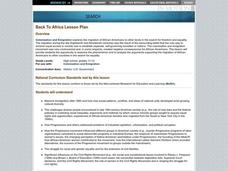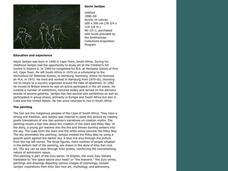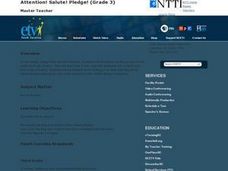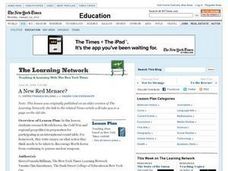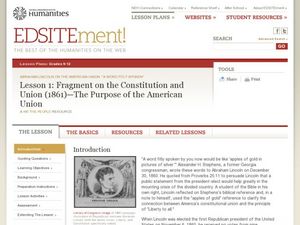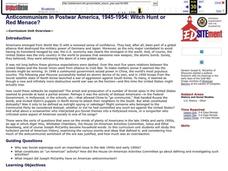Curated OER
Back To Africa
Learners analyze the massive immigration after 1850 and how new social patterns, conflicts, and ideas of national unity developed amid growing cultural diversity, and how the Progressive movement influenced different groups in American...
Curated OER
North and South
Young scholars study the Civil War and the changes it brought to our country. They examine some of Robert E. Lee's accomplishments and the contributions he made as president to Washington and Lee University. They make a map showing which...
Curated OER
Let Your Motto Be Resistance: African American Portraits
Learners compare and contrast historical and contemporary photographs of important figures in African American history. In this photography analysis lesson, students learn key photography vocabulary and use a Venn Diagram to explore...
Curated OER
From Slaves to Soldiers: African Americans in the Civil War
Tenth graders observe several films, including The Divided Union, focusing on the conditions of slavery and African American soldiers in the Union Army. In addition, they watch Uncle Tom's Cabin and Glory to reinforce their knowledge of...
Curated OER
Mount Rushmore
How did those faces get on that mountain, and why did they choose those particular presidents? Learn about Mount Rushmore's construction and the history behind the men represented on the mountainside with a short reading passage and set...
Curated OER
Meso-America
Students will identify and locate Central and South America and their countries and features, as well as Meso-American civilizations. Students will compare civilizations and discuss voyages of relevant explorers.
Curated OER
Attention! Salute! Pledge!
Third graders recognize the American flag as a symbol. In this symbols lesson, 3rd graders review the video "U.S. Flag: Proper Use" and identify what the stars and stripes represent. Students view an online clip of how to fold the...
Curated OER
Barbara Jordan
Young scholars examine the contributions made to our country by Barbara Jordan. They read and discuss the books "The Sneetches" and "Building a Bridge," write journal entries, participate in a discrimination simulation, create a class...
Curated OER
World Map and Globe
Students locate and identify continents and countries. In this world map lesson, students locate and identify one country on each continent.
Stanford University
Observing Human Rights Day
How much intervention is appropriate for America to take in cases of human rights violations? Class members ponder a question that has lingered since the birth of America with a series of primary sources that reflect the degree to which...
Curated OER
Freedom is Not Free, Lest We Forget
Learners explore the causes of the American Revolution. In this American Revolution lesson plan, students describe the major and important people of the Ameican Revolution. Learners watch videos fill out timelines do Internet research to...
Curated OER
Westward Expansion and the Frontier
Young scholars explore U.S. history by researching a historic map. In this westward expansion lesson plan, students discuss the mystery of the western U.S. in the early 1800's and the impact expansion had on Native Americans and...
Curated OER
A New Red Menace?
Students research and analyze the current political situation of North Korea. They read and discuss an article, conduct research, participate in a simulation of an international round table, and write a response essay.
Curated OER
The Homestead Act of 1862
Students, in groups, study the Homestead Act. Each group studies a region of the country in the 1840s: the North, the South, and the West. Ask each group to research and write their region's position on the homestead issue.
Curated OER
Spanish Influence in America
Students try out instruments from South America. In this multiculturalism lesson plan, students discuss the attributes of Latin American music and play instruments from South America.
Curated OER
Latin America: 1500-Present
In this Latin American history study guide worksheet, learners read a brief overview pertaining to the history of Latin America from 1500 to the present and fill in the blanks with the appropriate words. Students also respond to 23 short...
Curated OER
Fragment on the Constitution and Union (1861). The Purpose of the American Union
Eleventh graders examine how President Lincoln formulated the principles of the Declaration of Independence as the goal of the American Union. For this American Government lesson, 11th graders read and analyze primary sources based on...
California Polytechnic State University
Australian Geography Unit
At the heart of this resource is a beautifully detailed PowerPoint presentation (provided in PDF form) on the overall physical geography of Australia, basic facts about the country, Aboriginal history, and Australia culture and lifestyle.
Curated OER
Witch Hunt or Red Menace? Anticommunism in Postwar America, 1945-1954
Students investigate what constitutes an "un-American" activity and why Soviet espionage was such an important issue in the 1940's and 1950's. Joseph McCarthy's impact on American anticommunism is examined in this lesson. There are three...
K12 Reader
The Attack on Pearl Harbor
After reading a short passage about Japan's involvement in World War II and why the Japanese attacked Pearl Harbor, readers are asked to analyze how the attack effected the attitudes of Americans who previously had not wanted to go to war.
University of California
The Civil War: Effects of the Civil War
Imagine being on the front line of the Civil War —from the front porch of your own house. Scholars use visual evidence from primary and secondary sources to analyze the impact of the Civil War on all Americans. They examine the research...
University of Texas
Understanding Migration
Human migration—often the result of push and pull factors—sometimes has dramatic outcomes for both those leaving their homelands and the host countries. Using a variety of case studies, learners consider those issues. Then, by completing...
Teaching for Change
A Documents-Based Lesson on the Voting Rights Act
How did the Voting Rights Act affect the daily lives of American citizens? A document-based lesson developed by the Student Non-Violent Coordinating committee (SNCC) presents a case study of the impact of the Voting Rights Act of 1965 on...
Curated OER
Writing Exercises: Science and Technology II
All revolutions in science and technology have both pros and cons. Kids examine the advent of the green revolution, nuclear growth, use, and the countries that are considered nuclear powers. They'll construct three responses to each of...


